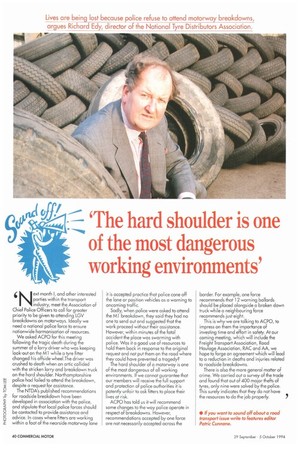The hard shoulder is one of the most dangerous working environments'
Page 42

If you've noticed an error in this article please click here to report it so we can fix it.
N ext month I, and other interested
parties within the transport industry, meet the Association of Chief Police Officers to call for greater priority to be given to attending LGV breakdowns on motorways. Ideally we need a national police force to ensure nationwide harmonisation of resources.
We asked ACK) for this meeting following the tragic death during the summer of a lorry driver who was keeping look-out on the M1 while a tyre fitter changed his offside wheel.The driver was crushed to death when an artic collided with the stricken lorry and breakdown truck on the hard shoulder. Northamptonshire police had failed to attend the breakdown, despite a request for assistance. The NTDA's published recommendations for roadside breakdown have been developed in association with the police, and stipulate that local police forces should be contacted to provide assistance and advice. In cases where fitters are working within a foot of the nearside motorway lane it is accepted practice that police cone off the lane or position vehicles as a warning to oncoming traffic. Sadly, when police were asked to attend the M1 breakdown, they said they had no one to send out and suggested that the work proceed without their assistance. However, within minutes of the fatal accident the place was swarming with police. Was it a good use of resources to hold them back in response to the original request and not put them on the road where they could have prevented a tragedy? The hard shoulder of a motorway is one of the most dangerous of all working environments. If we cannot guarantee that our members will receive the full support and protection of police authorities it is patently unfair to ask fitters to place their rives at risk.
ACPO has told us it will recommend some changes to the way police operate in respect of breakdowns. However, recommendations accepted by one force are not necessarily accepted across the
border. For example, one force recommends that 12 warning bollards should be placed alongside a broken down truck while a neighbouring force recommends just eight.
This is why we are talking to ACP°, to impress on them the importance of investing time and effort in safety. At our coming meeting, which will include the Freight Transport Association, Road Haulage Association, RAC and AA, we hope to forge an agreement which will lead to a reduction in deaths and injuries related to roadside breakdowns.
There is also the more general matter of crime. We carried out a survey of the trade and found that out of 400 major thefts of tyres, only nine were solved by the police. This surely indicates that they do not have the resources to do the job properly.




























































































